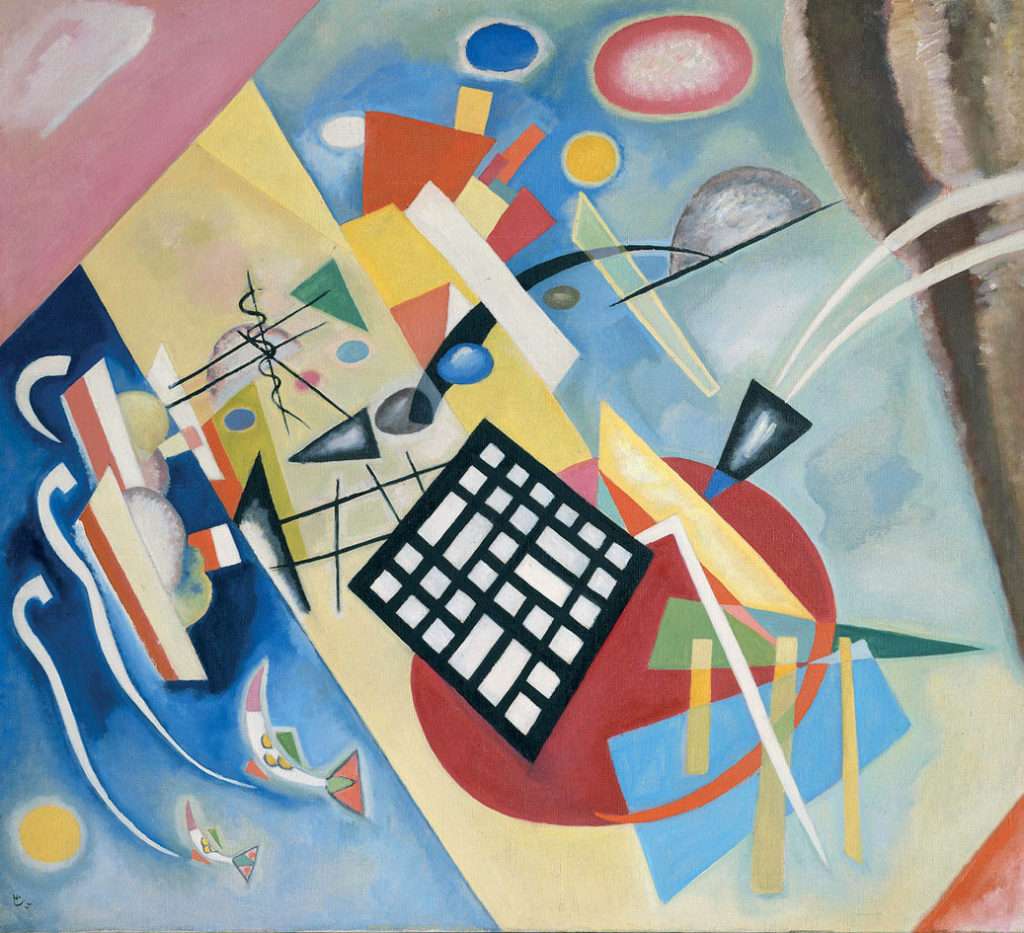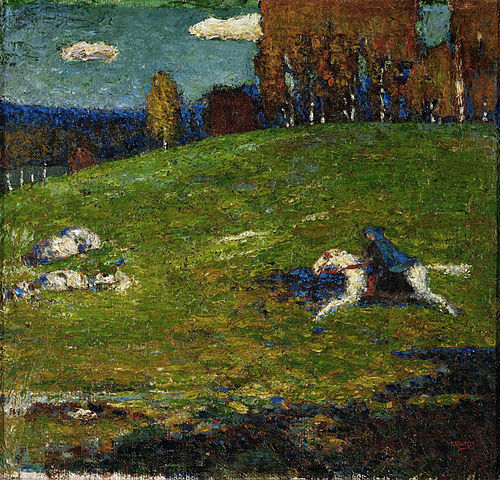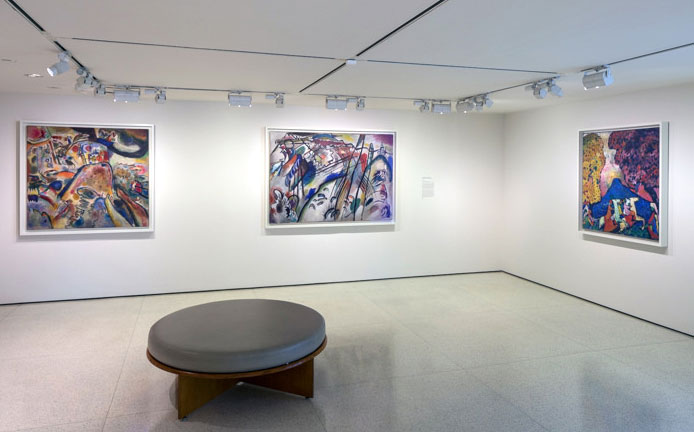Take An Artistic Journey With The Father of Abstraction
 Wassily Kandinsky, Black Grid (Schwarzer Raster), 1922, oil on canvas, 37-13/16″ × 41-3/4″. Photo: Public Domain in the U.S.
Wassily Kandinsky, Black Grid (Schwarzer Raster), 1922, oil on canvas, 37-13/16″ × 41-3/4″. Photo: Public Domain in the U.S.
Wassily Kandinsky was a modern master who is credited with painting the first purely abstract works. His life encompassed a brilliant career as a renowned painter, printmaker, watercolorist, theoretician, and Bauhaus teacher.
Born in Moscow, Russia, Wassily Wassilyevich Kandinsky, in 1866, he lived for 78 years. His monumental accomplishments span almost all the major artistic movements of the first half of the twentieth century.
On his way to developing his own signature style he embraced all artistic styles — from Art Nouveau’s sinuous, organic forms, to Fauvism and Blaue Reiter’s shocking colors, to Surrealism’s mysteries, and the Bauhaus period’s focus on Constructivism, and more.
Kandinsky felt the color blue was the most spiritual color.
 In Blue, oil on canvas. 31.5″ × 43.3″, created in 1925. Photo: Public Domain via wikimedia.org
In Blue, oil on canvas. 31.5″ × 43.3″, created in 1925. Photo: Public Domain via wikimedia.org
Kandinsky Gave Up Teaching Law to Pursue Art
Kandinsky created art during a time of experimentation and innovation amidst the upheavals of a society entering the modern world.
Like so many young budding artists, Kandinsky had been fascinated and stimulated by color as a child. However, mostly due to the urging of his parents, he studied law and economics.
When he was 30 years old he was appointed Professor to the Department of Law, at Derpt University in Tartu. However, he gave up this promising career teaching in order to follow his love for painting. He enrolled in art school in Munich. He was not accepted immediately, so he began learning art on his own. Indeed, he was determined to follow his dream.
It is widely known that Kandinsky’s decision to pursue his artistic passion was greatly influenced when viewing an exhibition of the French impressionists. After seeing the powerful sense of color in Monet’s “Haystacks”, there was no turning back.
 Wassily Kandinsky, Der Blaue Reiter (The Blue Rider), oil on canvas, 20.5″ × 21.4″. Created in 1903. Photo: Public Domain.
Wassily Kandinsky, Der Blaue Reiter (The Blue Rider), oil on canvas, 20.5″ × 21.4″. Created in 1903. Photo: Public Domain.
He Pursued Deeply Spiritual Abstraction
Kandinsky is most known for his spiritual abstraction and led other abstract painters who believed that art should provide a religious message. As opposed to traditional realism that focused on physical matter and materialism, abstract artists focused foremost on the spirit.
His seminal treatise Über das Geistige in der Kunst (Concerning the Spiritual in Art), published in Munich in December 1911, lays out his program for developing an art independent from observations of the external world and his tenets for artistic creation as a spiritual art. This material, in addition to his artwork advanced abstract art to a style free from nature. The development of a new subject matter based solely on the artist’s “inner necessity” would occupy him for the rest of his life. In 1926, while teaching at the Bauhaus, he expanded upon these theories in his writing and developed “Point and Line to Plane”. It dealt with the deep analytical studying of separate elements of a picture.
 Wassily Kandinsky, Blue Mountain, oil on canvas, 194.3 x 129.3 cm. Created in 1908 in Munich / Monaco, Germany. Current location: Solomon R. Guggenheim Museum, New York City, NY, US. Photo: Public domain. wikiart.org
Wassily Kandinsky, Blue Mountain, oil on canvas, 194.3 x 129.3 cm. Created in 1908 in Munich / Monaco, Germany. Current location: Solomon R. Guggenheim Museum, New York City, NY, US. Photo: Public domain. wikiart.org
The Influence of Music in His Art
Kandinsky often wrote about the many correlations between painting and composing music. He viewed music as the most transcendent form of non-objective art. He emphasized how musicians could evoke images, colors and forms in listeners’ minds merely with sounds. He continued to produce object-free paintings that suggested sounds and emotions through a unity of sensation.
One of his famous quotations is: “Colour is the keyboard, the eyes are the hammers, the soul is the piano with many strings. The artist is the hand which plays, touching one key or another, to cause vibrations in the soul.”
Kandinsky’s Art at The Guggenheim Museum

Perhaps more than any other twentieth-century painter, Kandinsky has been linked to the history of the Solomon R. Guggenheim Museum. “Vasily Kandinsky: Around the Circle” was organized by Megan Fontanella, Curator, Modern Art and Provenance, October 8, 2021–September 5, 2022. In this exhibition, Kandinsky’s work unfolded in reverse chronological order, starting with his late-life paintings and proceeding upward along the Guggenheim’s spiral ramp.
Links to Kandinsky’s art exhibitions and videos are on the museum’s website. They include his presentation of seven select canvases from the Guggenheim collection traces Kandinsky’s aesthetic evolution: his early beginnings in Munich at the start of the century, the return to his native Moscow with the outbreak of World War I, his interwar years in Germany as a teacher at the Bauhaus, and his final chapter in Paris.
Read more about Wassily Kandinsky
wassilykandinsky.net
wassily-kandinsky.org
Such an inspiring artist thank you for interesting information kind regards Elaine